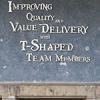 |
Management Myth 32: I Can Treat People as Interchangeable Resources It is unfortunate that the department attending to employees is called “Human Resources.” That language colors what managers call people in the organization. But the more you call people “resources,” the more they become interchangeable—and more like desks, or infrastructure, or something that is easily negotiable. Resources are not people. People are not resources.
|
|
 |
Why Prototyping First Leads to Better End Products Even with pages of documentation, there still can be miscommunication and misguided assumptions about a product. A prototype serves as the vision for the product and helps everyone, from a salesperson to an engineer, understand what they are trying to achieve. This article looks at some of the benefits of prototyping early in the development process.
|
|
 |
Improving Quality and Value Delivery with T-Shaped Team Members Thomas Wessel presents how T-shaped and pi-shaped teams based on each member's span of knowledge, ability to collaborate, and depth of expertise play an important part in how effectively your team performs.
|
|
 |
Why Does the Business Think Everything Should Be Simple, Fast, and Cheap? Whether they're on the business side or the IT side, professionals in the software industry tend to agree that more communication about project expectations is needed. So why is it that when the two sides collaborate, bad things seem to happen? Ryan McClish and Kenton Bohn analyze the human dynamics and show how to build a solution that accomplishes the defined goals.
|
|
 |
Avoiding the Organizational Death Spiral The death spiral supersedes the death march in that the death march is a singular event, whereas the death spiral is systemic. It is the result of organizational dysfunction where teams march toward deadline after deadline without reflecting on or questioning if there is a better way to deliver software. There is! Take these positive steps.
|
|
 |
From Proposal to Project: An Interview with Larry Putnam Jr.
Video
Larry Putnam Jr., co-chief executive officer at QSM, sits down to talk about the importance of the proposal when executing a successful project, five key questions that should be answered before any project starts, and how software estimation ties into the proposal process.
|
|
 |
Practical Performance Testing on Any Budget Testing application performance prior to release is an essential part of managing risk in any software project. But the budget must be considered when talking performance testing; you want to know what it is going to cost to build and maintain a system that supports the project goals. However, there are ways to test the performance of your project while keeping the effort to a manageable set of tasks that get the job done without breaking the bank.
|
|
 |
Myth 31: I Don’t Have to Make the Difficult Choices "Don't bring me problems; bring me solutions." Sound familiar? Sounds like a management cop out to Johanna Rothman. A primary purpose of managers is to help their teams perform to the best of their abilities, and that includes stepping up and making tough decisions to help solve problems.
|
|
 |
Why Am I Always Getting Bad News in the Eleventh Hour? This article is a departure from previous columns. Kenton and Ryan role play the stress and friction between a typical product manager and an engineering team lead. This article may make you squirm, but it brings out the issues of teams attempting to do the best thing from completely different perspectives.
|
|
 |
My Team Is Agile, but My Organization Is Not! What Can I Do? In this FAQ column, Sanjiv Augustine advises how to upgrade your organization's portfolio management by addressing inefficient, outdated, and value-killing portfolio management processes.
|
|

